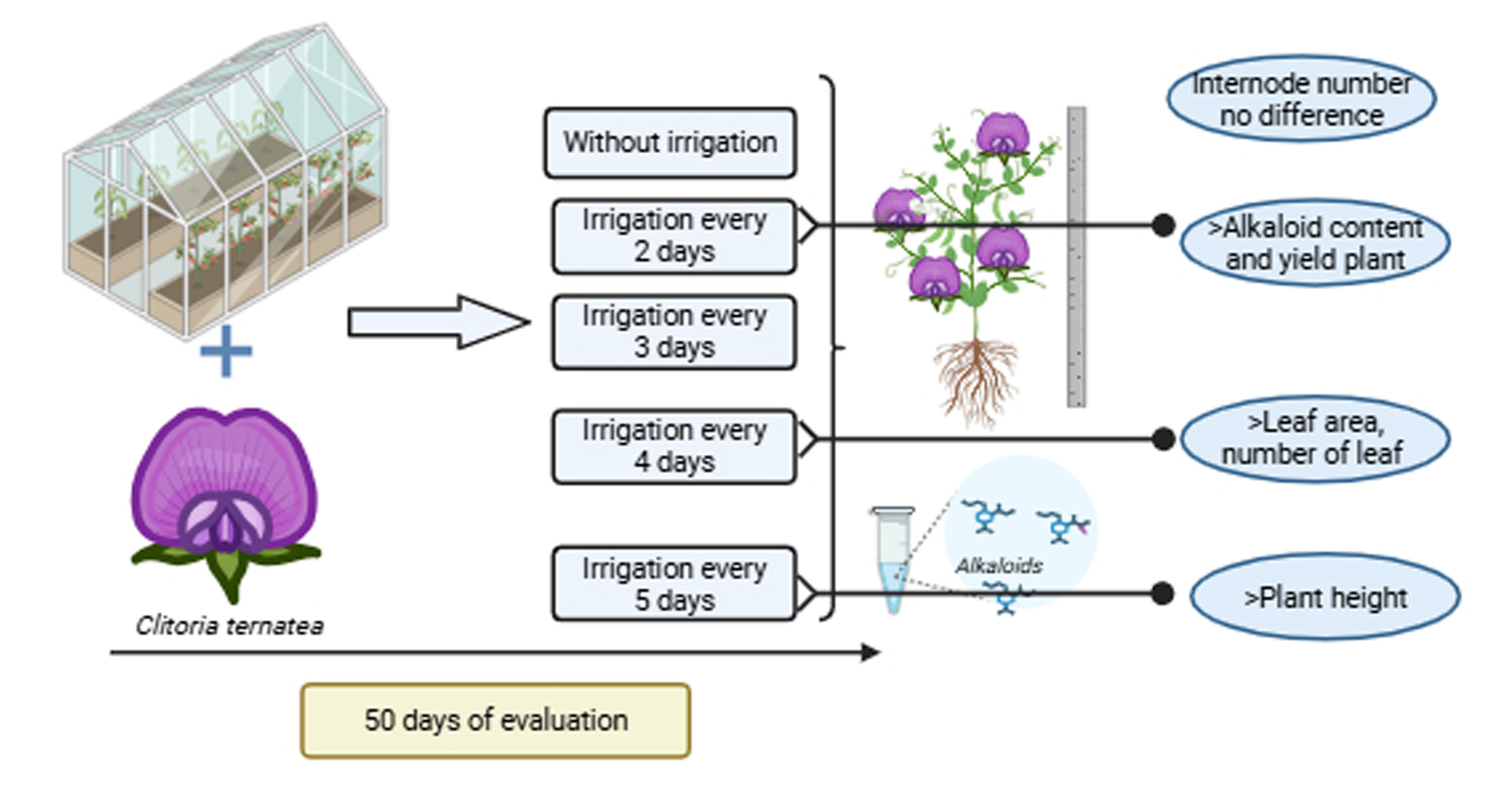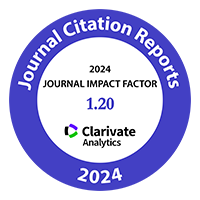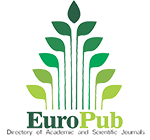Growth and Foliar Alkaloid Content of Clitoria ternatea under Different Irrigation Frequencies
Keywords:
alkaloids, height, leaf area, number of leaves, yieldAbstract

Clitoria ternatea is widely used in tropical livestock farming. This study evaluates the agronomic performance and alkaloid content of C. ternatea under different irrigation frequencies in protected cultivation. A randomized block design with controlled manual irrigation was implemented with five treatments, four replicates, and five experimental units per treatment. Treatments included daily irrigation (T0), irrigation every two days (T1), every three days (T2), every four days (T3), and every five days (T4). We evaluated plant height, leaf and internode number, leaf area, green and dry matter yield, and alkaloid content. Irrigation every three or four days generally resulted in the highest values for the measured variables compared to the control. Reduced irrigation frequency affects the agronomic performance of C. ternatea in protected cultivation. Agronomic indicators were highest under irrigation every three or four days. Alkaloid content did not vary with irrigation frequency.
Highlights:
- Clitoria ternateais widely used in tropical livestock farming due to its adaptability, productivity, and nutritional value.
- Thestructured design with controlled manual irrigation had five treatments, four replicates and five experimental units, totalizing 100 plants.
- Maximum plant height was achieved when Clitoria ternateareceived irrigation every four or five days, with T4 reaching 48.50 cm at 50 days
- Leaf number increased as plants matured, with the highest value recorded in T3 (48 leaves at 50 days).
- Irrigation every 2 days increases alkaloid content and plant yield.
Downloads
References
AOAC (Association of Official Analytical Chemists). 2016. Official Methods of Analysis of AOAC International. 20th Ed. George W. Latimer Jr (ed).
Boutin, R. 2023. Protocolo de rendimiento real en Kg/Ha. https://www.finagro.com.co/sites/ default/files/protocolo_de_muestreo_para_la_operacion_de_la_poliza.pdf, (accessed on September 15th 2023).
Castrejón-Pineda, F. A.; Corona-Gochi, L.; Rosiles-Martínez, R.; Martínez-Pérez, P.; Lorenzana-Moreno, A. V.; Arzate-Vázquez, L. G. 2023. Características nutrimentales de gramíneas, leguminosas y algunas arbóreas forrajeras del trópico mexicano: fracciones de proteína (A, B1, B2, B3 y C), carbohidratos y digestibilidad in vitro. Universidad Nacional Autónoma de México: https://papimes.fmvz.unam.mx/proyectos/manuales_nutricion/Manual, (accessed on September 18th 2023).
Espinoza-Coronel, A. L.; Franco Ochoa, D. A.; Fajardo Espinoza, P. G.; Real Goya, G. E.; Pincay-Ganchozo, R. A. 2020. Nexo Agropecuario. 8(2): 43-50. https://www.researchgate. net/publication/347507134
Estrada-Jiménez, P. M.; Ramírez, J. L.; Verdecia, D. M. 2019. Aplicación de la minería de datos en la estimación de componentes fotoquímicos. ROCA Revista Científico-Educaciones de la provincia de Granma. 15(2): 177-186.
Holopainen, J. K.; Virjamo, V.; Ghimire, R. P.; Blande, J. D.; Julkunen-Titto, R.; Kivimäenpää, M. 2018. Climate change effects on secondary compounds of forest trees in the Northern Hemisphere. Frontiers in Plant Science. 9: 1445. DOI: https://doi.org/10.3389/fpls.2018.01445
Instituto Nacional de Meteorología e Hidrología. 2023. Las condiciones agrometeorológicas del Cantón La Maná. http://www.inamhi.gob.ec, (accessed on September 12nd 2023).
Jácome-Gómez, L. R.; Ramírez-Villalobos, M. 2021. Incidencia del sombreado, biorreguladores y bioestimulante en el desarrollo y rendimiento del pasto Mombaza (Panicum maximum Jacq.). Rev. Fac. Agron. (LUZ). 38 (2): 382-403. https://www.produccioncientificaluz.org/ index.php/agronomia/ article/view/35505
Jamil, N.; Naqiuddin, M.; Mohd, N.; Paee, F. 2018. Influences of enviromental conditions to phytoconstituents in Clitoria ternatea (butterfly pea flower): A review. J. Sci Technol. 10: 208-228. DOI: http://10.30880/jst.2018.10.02,029
Luna Murillo, R.; Chacón Marcheco, E.; Ramírez de la Ribera, J.; Espinoza Coronel, A.; Guevara Santana, J.; Cedeño Troya, D. M.; López Cedeño, K. M. 2015. Evaluación del Kudzú (Pueraria phaseloides) y la Clitoria ternatea en diferentes estados de madurez. Revista Electrónica de Veterinaria. 16(10): 1-9. http://www.veterinaria.org/revistas/redvet/n101015.html
Macías-Pettao, R.; Tapia-Ramírez, S.; Pincay-Ganchozo, R.; Álvarez-Perdomo, G. 2021. Respuesta agronómica y composición química de Clitoria ternatea l. en el subtrópico. Nexo Agropecuario. 9(2): 13-18.
Mahfouz, H.; Megawer, E. A.; Maher, A.; Shaaban, A. 2020. Integrated effect of planting dates and irrigation regimes on morpho-physiological response, forage yield and quality, and water use efficiency of clitoria (Clitoria ternatea L.) in arid region. Arch. Agron. Soil Sci. 66 (2): 152-167. DOI: https://doi.org/10.1080/03650340.2019.1605165
Moraes, A.; Medeiros, S.; Fagundes, I. 2021. Estresse hídrico em plantas: uma revisão. Research, Society and Development. 10(15): 1-7. DOI: http://dx.doi.org/10.33448/rsd-v10i15.23155
Muñoz-González, J. C.; Huerta-Bravo, M.; Lara-Bueno, A. 2016. Producción y calidad nutrimental de forrajes en condiciones del Trópico Húmedo de México. Revista mexicana de Ciencias Agrícolas. 7(SPE16): 3315-3327.
Paniagua, L.; Arias, L. Alpízar, A.; Castillo, M.; Camacho, M.; Padilla, J.; Campos, M. 2018. Efecto de la densidad de siembra y edad de rebrote en la producción y composición bromatológica de Tithonia diversifolia (Hemsl.) A. Gray. Pastos y Forrajes. 43(4): 275-283. http://scielo. sld.cu/scielo.php?script=sci_arttext&pid=S0864-03942020000400275&l-ng=es&tlng=es
Piccinetti, C.; Eöry, C. A.; Prieto, G. M.; Vallejo, D. A.; Enrico, J. M.; Salvagiotti, F.; Perticari, A. 2024. Selection of Rhizobium leguminosarum strains via symbiotic and production variables in Pisum sativum L. Revista de la Facultad de Ciencias Agrarias. Universidad Nacional de Cuyo. Mendoza. Argentina. 56(1): 1-1. DOI: https://doi.org/10.48162/rev.39.118
Pincay-Ganchozo, R.; Luna-Murillo, R.; Espinosa-Cunuhay, K.; Espinales-Suárez, H. 2021. Escarificación química y biológica en la emergencia y crecimiento de Clitoria ternatea. 48(3): 53-59.
Ramírez-Villalobos, M.; Urdaneta-Fernández, A.; Suárez, H.; Iglesias-Gómez, J. 2023. Distribución de materia seca, área foliar y calidad nutricional en dos genotipos de Clitoria ternatea L. Pastos y Forrajes. 46(2): 1-9.
Rendón, J. 2023. Capacidad extractora de cadmio en materiales genéticos de cacao procedentes de la colección del Instituto Nacional de Investigaciones Agropecuaria- EETP. http:// repositorio.utc.edu.ec/handle/27000/8572, (accessed on September 11st 2023).
Renté-Martí, O.; Pablos-Pablo, R.; Corrales-Vila, Y. 2020. Canavalia ensiformis (L): en propiedades químicas de un suelo fluvisol diferenciado. Revista científica del Amazonas. 3(6): 65-75.
Rosas-Quina, Y. 2020. Efecto del tamaño de partícula en la extracción de alcaloides del tarwi (Lupinus mutabilis) Sweet) por método convencional. Peruvian Agricultural Research. 2(1). http://doi.org/10.51431/par.v2i1.619
Shamnad, J. 2019. Mineral and nutritional potential of Clitoria ternatea L. variants as forage. J. Trop. Agric. 57(2): 163-166. http://jtropag.kau.in/index.php/ojs2/article/view/867
Sosa-Montes, E.; Alejos-de la Fuente, J. I.; Pro-Martínez, A.; González-Cerón, F.; Enríquez-Quiroz, J. F.; Torres-Cardona, María G. 2020. Composición química y digestibilidad de cuatro leguminosas tropicales mexicanas. Rev. Mex. Cienc. Agríc. 11 (spe24): 211-220, DOI: https://doi. org/10.29312/remexca.v0i24.2371
Taiz, L.; Zeiger, E.; Møller, I. M.; Murphy, A. 2015. Plant physiology and development. Sunderland. 15-34.
Turnos, J. L. 2021. Influence of light intensity on the growth and yield of blu ternate (Clitoria Sp.) Asian Journal of Fundamental and Applied Sciences. 2(2): 1-14.
Santana Cabrera, J. A.; Lozada Caisa, M. A.; Gavilánez Buñay, T. C.; Salazar Arias, J. P.; Chuquitarco Esmeraldas, V. A. 2022. Evaluación del extracto de Clitoria ternatea como bioestimulante en el cultivo de frijol. Ciencia Latina Revista Científica Multidisciplinar. 6(4): 1931-1945. DOI: https://doi.org/10.37811/cl_rcm.v6i4.2719
Verdecia, D.; Herrera-Herrera, R.; Torres, E.; Sánchez, A.; Hernández- Montiel, L.; Herrera, R.; Ramírez, J. L.; Bodas, R.; Giráldez, F.; Guillaume, J.; Uvidia, H.; López, S. 2021. Primary and secondary metabolites of six species of trees, shrubs and herbaceous legumes. Cuban Journal of Agricultural Science. 5(1): 1-17.

Published
How to Cite
Issue
Section
License
Copyright (c) 2018 Revista de la Facultad de Ciencias Agrarias UNCuyo

This work is licensed under a Creative Commons Attribution-NonCommercial-ShareAlike 3.0 Unported License.
Aquellos autores/as que tengan publicaciones con esta revista, aceptan las Políticas Editoriales.












.jpg)




